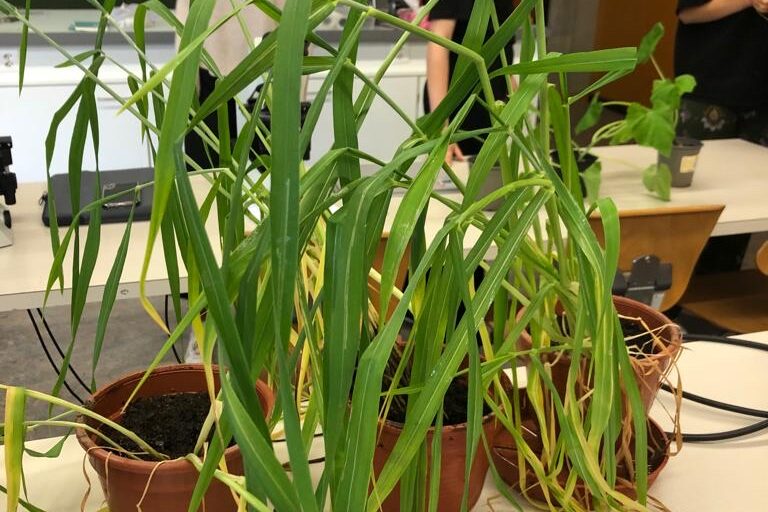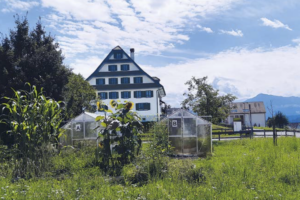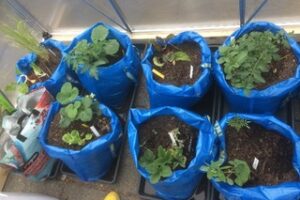“Climate change” workshop in the geography supplementary subject
The class of the supplementary subject geography were excited about the next few hours and what was in store for them in the biology room. It was clear that plants from the two greenhouses provided by ETHZ were to be analysed.
Now the time had come. Three motivated women from ETH Zurich stood in front of the whole class, ready to present the project. In principle, the aim was to find out what effect global warming has on food crops. In order to find out which plants are potential climate winners and which are potential climate losers, different plant species were planted in two different greenhouses. One of the two was to be kept at +2 degrees Celsius and the other at +5 degrees Celsius. This could not be realised in our greenhouses due to various factors. There was a temperature difference in the two greenhouses, but not exactly +2 and +5 degrees Celsius respectively. In addition, one specimen of each plant species was desiccated and another was flooded. This preparation had already taken place a few weeks earlier. Now it was our turn to analyse the plants.
We began our research using three different examination methods.
Our favourite experiment; microscopy
Our plant research began with the help of clear nail polish and a light microscope. We were able to brush individual parts of the leaves with nail polish and let it dry. The nail polish was then carefully removed from the leaf and the piece of nail polish, which now also contained the structure of the leaf surface, was ready for microscopy.
The stomata cells of a plant can be seen in the illustration. The stomata are very important for a plant to absorb nutrients and could also be called the “pores of the plant”. When they are closed or almost closed, the plant has optimally absorbed enough water. But if this is not the case, they could be dying of thirst and close their “pores” to protect themselves.



More practical experiments
In addition to the microscope, the various groups carried out two other experiments to find out whether the plants were climate winners or climate losers. The main aim was to investigate how plants react to extreme temperatures, because in the future not only will it be warmer due to climate change, but there will be more extreme weather situations, such as the long rainy days of July.
It was also about measuring the levels of carbon dioxide. During the evaluation at the end of the afternoon, we were able to use the values to find out exactly how the plants react to changes in their environment.
Thought experiment
After and during the practical experiments, with which the experts from ETH Zurich helped us, we thought about how we could improve the situation of the plants so that they do not suffer from climate changes or produce less yield. So we thought about how plants, like people, will “climate migrate” in the future. When it gets warmer here, plants that come from southern regions will sometimes be able to live very well. In contrast, our plants may fare better in more northern areas.
In addition to this thought experiment, there are many others, such as considering how technology can help us better preserve plants. Greenhouses and irrigation systems already exist, which is clear to all of us, how to convert and optimize these existing plant habitats would be a next step towards a sustainable future for our plants.
Kaffichränzli in the Greenhouse
What I personally know from this afternoon is that there are plants that are either climate losers or climate winners. Or both at once? For example the emmer; We examined three different pots of emmer with different experiments, one had too much water, the other had too little and the third was watered normally. With these different waterings we tried to imitate the different conditions that are or may yet arise due to climate change. What I still remember very clearly is that my lab partner and I were very confused when we had to determine whether our emmer was a climate loser or a climate winner. Because the emmer in the pot with too much water turned out better than the one with the normal amount of water. But what conditions does the emmer prefer now? We thought about the fact that, depending on which part of the world it is planted in, emmer can be a climate loser or a climate winner.
In a final discussion we talked about what each of us can contribute to climate protection. What I took away from the final round was that if you always look at what the others are doing or not doing and you think, ‘Yeah, they’re not doing anything either, I can’t do anything on my own anyway, then I won’t do anything. ‘ that NOTHING will change. If you want to change something then do it and do it now. Inspire others with your actions and discuss them with them. ‘Raising awareness’ is very important.
I generally enjoyed the climate garden afternoon. The experiments were fun and were easy to carry out with the instructions in the script. It was interesting to do a little research yourself and compare your results with other groups who have studied other plants. It was great to have people there who had specialist knowledge and were able to answer many of our questions. The final discussion in the class seemed very important to me and gave me even more food for thought.
Workshop “Symbiosis” in the supplementary subject of biology
As part of the Climate Garden 2085 project, we set out to find one of the most fascinating examples of symbiosis, mycorrhiza. Many weeks before the workshop, various crops such as peas, emmer and chickpeas had to be sown and half inoculated with mycorrhizal fungi. We cared for the plants until the workshop was held and hoped that the fungus would successfully colonize the plant roots. On the day itself we learned a lot of interesting facts about the interaction of these unlikely plant-fungus partners. We were then able to dig up some of our plants and prepare the roots for microscopy. When we finally had the finished specimens under the microscope, we were suddenly disappointed. Unfortunately, our expectation that the mycorrhizae colonized the plants was not confirmed. We immediately started troubleshooting and came to the conclusion that perhaps the time between inoculation and testing was too short and that the fungi had not yet been able to grow into the plant roots. We experienced first-hand that setbacks are also part of the work of a scientist. But when you work with living organisms there are a lot of unforeseen things. Nevertheless, we learned a lot and the workshop was a welcome change from everyday school life. The scientist’s comments were particularly interesting and gave us a good insight into very specific research work.
Translated from German





